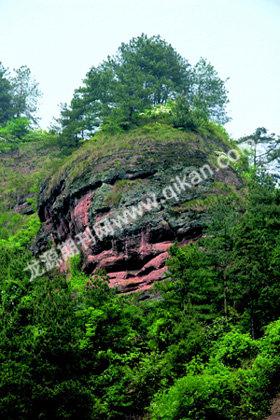Bodhidharma Comes to Jiufeng Mountain
Hong Tiecheng

Jiufeng Mountain, a provincial scenic zone 28 km west of Jinhua in central Zhejiang, features a typical Danxia landform: steep cliffs in reddish tints. Similar landform can be found in upper reaches of the Grand Canyon in USA and Meteora on the Mountain Olympus in Greece although they are not categorized under the name of "Danxia landform type". The spectacular mountain has nine towering peaks which look as if they were hewn and hacked by craftsmen from heaven. Half way up the mountain is a huge cave in which a smaller cave can be found. Legend has it that Bodhidharma once lived there. In the larger cave there are two stones. One looks like a chair and the other looks like a table. Legend has it that Bodhidharma used them.
For many people, the mountain is an important footnote to the life of the legendary Buddhist monk who came from India with Zen. Bodhidharma arrived in southern China in 520 AD. He met with Emperor Wudi of the Liang Dynasty. Learning that a Buddhist monk had arrived from India, the emperor sent for him and was eager to learn something from the monk. However, the emperor was hugely disappointed with the answers from Bodhidharma. History says that the emperor did not understand the meaning of the answers and the monk knew the time for his new theory of Buddhism in China had not yet mature. So the two departed and the monk traveled south. After the emperors mentor became aware the monks answers revealed something quite new about Buddhism and explained his understanding to the emperor, the emperor sent people out to get the monk. The monk had come to a wide river. After hearing the rapid approaching of some horses, the monk snatched a part of reef and threw it into the water and stepped on the reef. The reef carried him all the way across the river. Bodhidharma came to Songshan Mountain and stayed at Shaolin Temple.
Chinese legends say that Bodhidharma spent nine years sitting in meditation facing a wall in a cave at the Shaolin Temple, but explanations vary about why he gazed at the wall and how he sat there for such a long time. One version relates this is how the Bodhidharma tested the sincerity of his disciple.
Bodhidharma cut off the young mans right arm before passing Zen on to the sincere disciple. With Bodhidharma, the Zen sector became the most prosperous Buddhist school in China after it arrived in the central kingdom in 67 AD. The blooming of Zen in China verified the prediction of Bodhidharmas master that Buddhism was to have a great destiny in China.
There are different stories about where Bodhidharma went after leaving the Shaolin Temple. Some say he was poisoned to death and buried in Xionger Mountain. Some say that he met his nirvana in another temple. Some say that he went home barefoot, carrying a shoe in his hand. But some say that Bodhidharma ended up in Jiufeng Mountain in Jinhua.
Local annals compiled in the middle years of the Ming Dynasty (1368-1644) mention that the monk died in 556 in Jiufeng Mountain. According to local history, the Indian monk founded some temples in other parts of Jinhua before he came to the Jiufeng Mountain where he founded a temple and chose to pass away there. It is said that the local villagers put him into a coffin and hanged the coffin on a steep cliff, the highest honor-funeral for anyone.
The “Record of the Buddhist Monasteries of Luoyang”, a book compiled in 547 AD by a Chinese writer and translator of Mahāyāna Buddhist texts into the Chinese language, relates that Bodhidmarda lived to 150 years. Hu Shi, a modern scholar in the 20th century, said that it was essentially credible that the Indian monk lived to the age of 150 years. □

